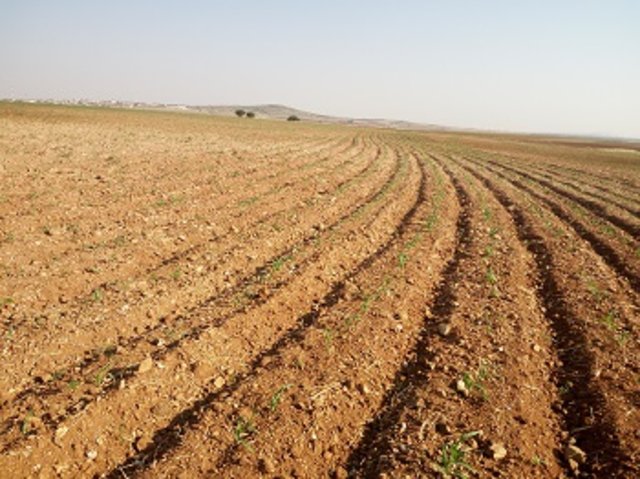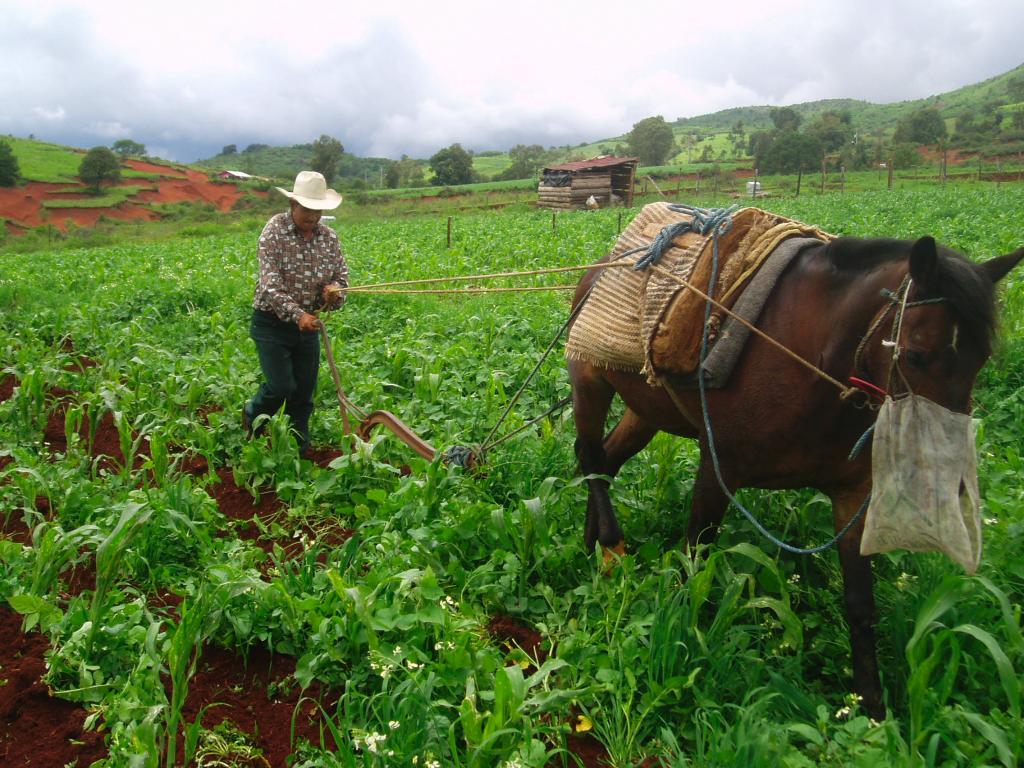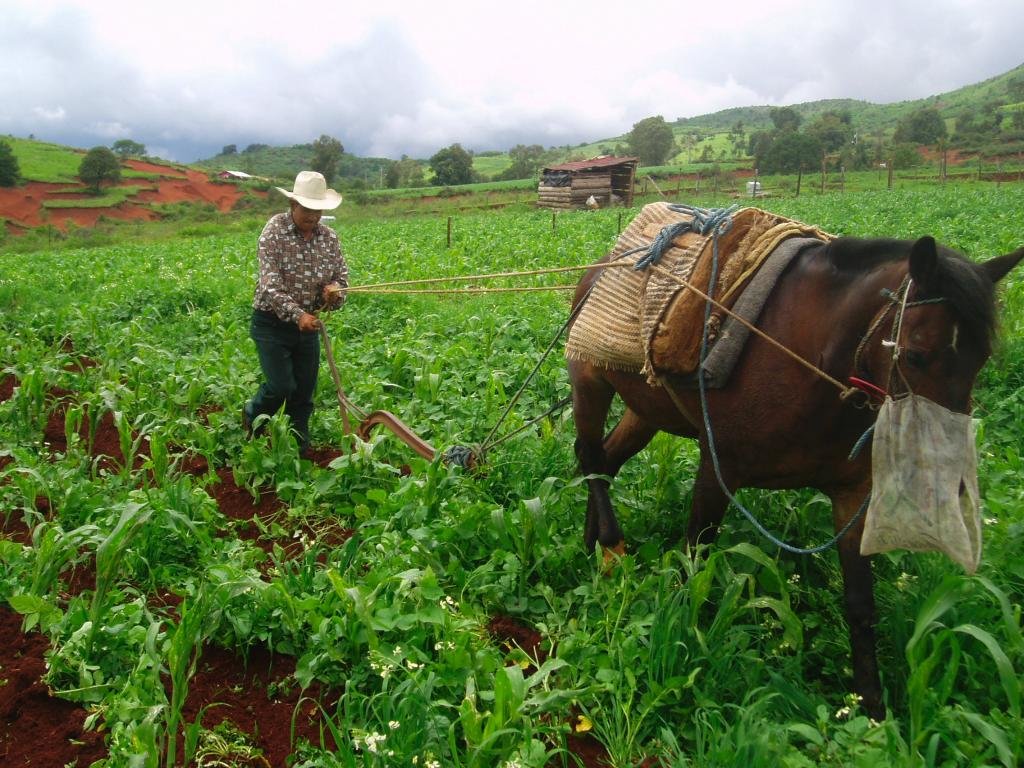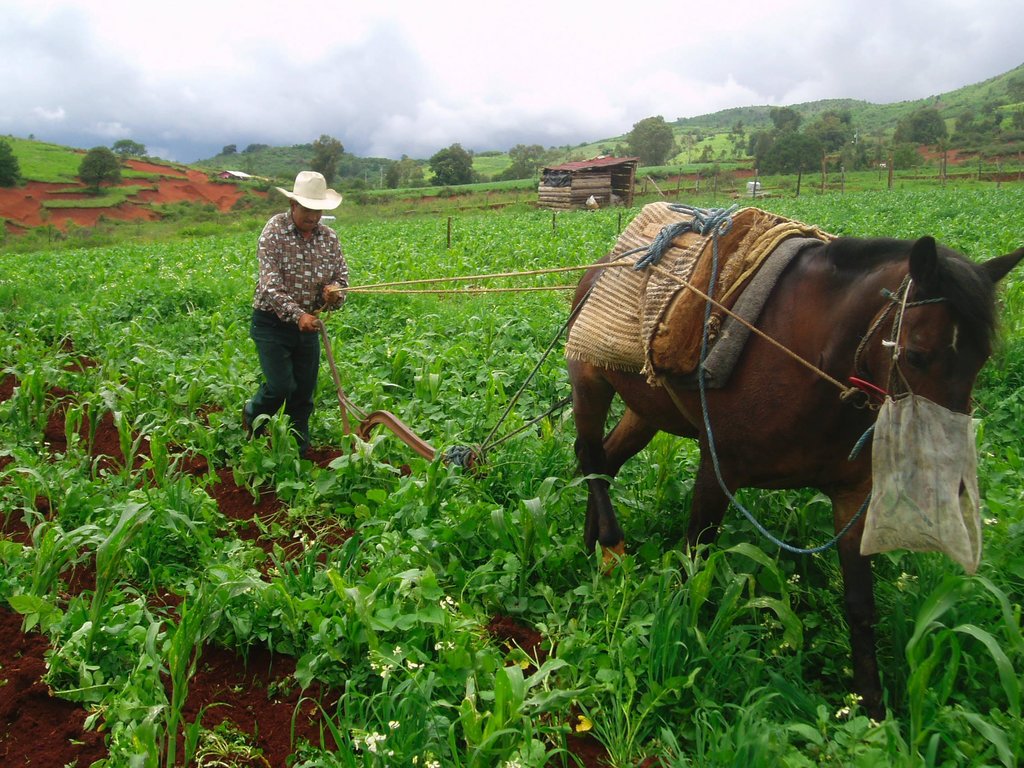Residue management of anual crop of maize/bean association [墨西哥]
- 创建:
- 更新:
- 编制者: Christian Prat
- 编辑者: –
- 审查者: Fabian Ottiger
Manejo de rastrojo de cultivo anual de la asociación maiz/frijol
approaches_2579 - 墨西哥
查看章节
全部展开 全部收起1. 一般信息
1.2 参与方法评估和文件编制的资源人员和机构的联系方式
有助于对方法进行记录/评估的机构名称(如相关)
Institut de recherche pour le développement IRD (Institut de recherche pour le développement IRD) - 法国1.3 关于使用通过WOCAT记录的数据的条件
编制者和关键资源人员接受有关使用通过WOCAT记录数据的条件。:
是
1.4 SLM技术问卷的参考

Sistemas de prácticas de MST en suelos con … [墨西哥]
El sistema de prácticas de MST en planicie con pendiente no mayores del 5%, la cual consiste en la rotación de cultivos en dos ciclos denominados primavera-verano y otoño-invierno, donde en una parcela de 5 hectáreas se combinan frijol-avena y maíz-calabaza y triticale. Para el caso de la rotación frijol-avena, …
- 编制者: Alejandra Castillo
2. SLM方法的描述
2.1 该方法的简要说明
Maize residue management with high input of crop residues and annual crop instead of year one crop and fallow in year 2
2.2 该方法的详细说明
该方法的详细说明:
Aims / objectives: The objetive is to evaluate the influence of different agronomic systems including conventional system (one year tillage and one year fallow), conservation system (high input of crop residues) with mineral fertilizers every year, conservation system (high input of crop residues) with organic fertilizer every year on: water run-off (quantity and quality), soil sediment transports, soil water content, soil cover, carbon capture, soils characteristics and their interactions with the production of the maize/bean crop association on Acrisol
Methods: Primary tillage for maize/beans it consisted in moldboard ploughing and furrowing, and one post-emergence weeding was done manually. Depth of tillage for moldboard plow was about 0.20m and for rototill, about 0.15 m. 3 seeds of corn or beans are planted and covered by foot. Fertilizer is put on the depression just after seeding and one month later during the post emergence weeding. This experiment have been done on Acrisol
Stages of implementation: The experiment is finished. Dissemination to the stakeholders and policy makers has been done. Policy makers took the results and are disseminating it to the other stakeholders
Role of stakeholders: Active. Visit to the field experiment site during the experimentation, workshops, etc...but the adoption of the technologies can be effective only if the system is deeply change. Farmers need thei fallow year for their animals. This proposal is just one element of the whole system to change.
Other important information: Important results to understand and measure the soil erosion and run-off with this kind of soil (Acrisol) with the traditionnal and improaved cultural system
2.3 该方法的照片
2.5 采用该方法的国家/地区/地点
国家:
墨西哥
区域/州/省:
Mexico/Michoacán
有关地点的进一步说明:
Morelia
2.6 该方法的开始和终止日期
注明开始年份:
2002
终止年份(若不再采用该方法):
2008
2.7 方法的类型
- 基于项目/方案
2.8 该方法的主要目的/目标
The Approach focused on SLM only (Soil conservation, water conservation, crop residue management, organic fertilizers, maize/bean association)
The area is strongly eroded and it was necessary to understand which factors could explain this situation and try agronomic alternatives to proposed to farmers to reduce it. In fact soil erosion is mainly due to the cattle free grazing in the field during the fodder and in commune land use for other part. The elimination of fodder year reduce presence of animals and increase production/productivity which can be given to the cattle. But this means to have less animals, more works and normally, more beneficits!
The SLM Approach addressed the following problems: Culivating every year means less space for the cattle which are the base of the agricultural system. the adoption of the technologies can be effective only if the system is deeply change. Farmers need the fallow year for their animals. This proposal is just one element of the whole system to change. New practice generates psychological resistance
2.9 推动或妨碍实施本办法所适用的技术的条件
社会/文化/宗教规范和价值观
- 阻碍
New practice generates psychological resistance
Treatment through the SLM Approach: Visit farmers using the new practice is very effective to convince other farmers
财务资源和服务的可用性/可得性
- 阻碍
Actually, farmers need the fallow year for their animals.
Treatment through the SLM Approach: Follow research to complete the whole agricultural system to be able to make a global proposal which will give much more money to live, and not to survive
了解SLM,获得技术支持
- 阻碍
Treatment through the SLM Approach:
工作量、人力资源可用性
- 阻碍
Means to work the double because farmers will have all their land to work, without any fallow
Treatment through the SLM Approach: Follow research to complete the whole agricultural system to be able to make a global proposal which will give much more money to live, and not to survive
3. 相关利益相关者的参与和角色
3.1 该方法涉及的利益相关者及其职责
- 当地土地使用者/当地社区
Atecuaro community
Men are more involucrate in tillage activities. Men perform hard labor job in the land, while women participate in the household tasks. Nearly all the farmers of the communities are poor!
- SLM专家/农业顾问
- 国家政府(规划者、决策者)
INIFAP (Mex. Agronomic Res.Inst.), COLPOS (Col. Postgraduate of agriculture), UNAM-CIEco, SEMARNAT (Sec. Environment)
- 国际组织
UE project (REVOLSO then DESIRE), IRD (France), CSIC (Spain)
3.2 当地土地使用者/当地社区参与该方法的不同阶段
| 当地土地使用者/当地社区的参与 | 指定参与人员并描述活动 | |
|---|---|---|
| 启动/动机 | 外部支持 | |
| 计划 | 外部支持 | |
| 实施 | 外部支持 | |
| 监测/评估 | 互动 | |
| Research | 互动 |
3.4 有关SLM技术选择的决策
具体说明谁有权决定选择要实施的技术:
- 主要是SLM专家,咨询土地使用者之后
解释:
Decisions on the method of implementing the SLM Technology were made by mainly by SLM specialists with consultation of land users
4. 技术支持、能力建设和知识管理
4.1 能力建设/培训
是否为土地使用者/其他利益相关者提供培训?:
是
明确受训人员:
- 土地使用者
- 现场工作人员/顾问
- Institutions
培训形式:
- 在职
- 农民对农民
- 示范区域
- 公开会议
4.2 咨询服务
土地使用者有权使用咨询服务吗?:
是
说明/注释:
Advisory service is quite adequate to ensure the continuation of land conservation activities
4.4 监测和评估
监测和评估是该方法的一部分吗?:
是
注释:
bio-physical aspects were regular monitored by project staff through observations
bio-physical aspects were regular monitored by project staff through measurements
technical aspects were regular monitored by project staff through observations
technical aspects were regular monitored by project staff through measurements
economic / production aspects were regular monitored by project staff through observations
economic / production aspects were regular monitored by project staff through measurements
area treated aspects were ad hoc monitored by land users through observations
management of Approach aspects were ad hoc monitored by government through observations
There were no changes in the Approach as a result of monitoring and evaluation
There were no changes in the Technology as a result of monitoring and evaluation
4.5 研究
研究是该方法的一部分吗?
是
明确话题:
- 生态学
- 技术
- Agronomy, hydrology, soil sciences
提供进一步的细节,并指出是谁做的研究:
Measures water run-off (quantity and quality), soil sediment transports, soil water content, soil cover, soils characteristics, carbone capture, production of maize and beans by INIFAP, IRD (France), COLPOS, UNAM-CIEco and CSIC (Spain)
Research was carried out both on station and on-farm
5. 融资和外部物质支持
5.1 该方法中SLM组成部分的年度预算
如果不知道准确的年度预算,请给出一个范围:
- < 2,000
注释(例如主要的资助来源/主要捐助者):
Approach costs were met by the following donors: local community / land user(s) (Atecuaro communities): 5.0%; government (INIFAP, COLPOS, UNAM-CIEco, SEMARNAT): 30.0%; international (UE project (REVOLSO, then DESIRE), IRD, CSIC): 65.0%
5.2 为土地使用者提供财政/物质支援
土地使用者是否获得实施该技术的财政/物质支持?:
否
5.3 对特定投入的补贴(包括劳动力)
- 无
6. 影响分析和结论性陈述
6.1 方法的影响
该方法是否帮助土地使用者实施和维护SLM技术?:
- 否
- 是,很少
- 是,中等
- 是,支持力度很大
mitigate water erosion effects and increase yields
该方法是否有助于社会和经济弱势群体?:
- 否
- 是,很少
- 是,中等
- 是,支持力度很大
Did other land users / projects adopt the Approach?
- 否
- 是,很少
- 是,中等
- 是,支持力度很大
Few land users due to the obligation to have new plough system, more work to manage the harvest residues
Did the Approach lead to improved livelihoods / human well-being?
- 否
- 是,很少
- 是,中等
- 是,支持力度很大
Did the Approach help to alleviate poverty?
- 否
- 是,很少
- 是,中等
- 是,支持力度很大
7. 参考和链接
7.1 方法/信息来源
- 实地考察、实地调查
- 与土地使用者的访谈
链接和模块
全部展开 全部收起链接

Sistemas de prácticas de MST en suelos con … [墨西哥]
El sistema de prácticas de MST en planicie con pendiente no mayores del 5%, la cual consiste en la rotación de cultivos en dos ciclos denominados primavera-verano y otoño-invierno, donde en una parcela de 5 hectáreas se combinan frijol-avena y maíz-calabaza y triticale. Para el caso de la rotación frijol-avena, …
- 编制者: Alejandra Castillo
模块
无模块





